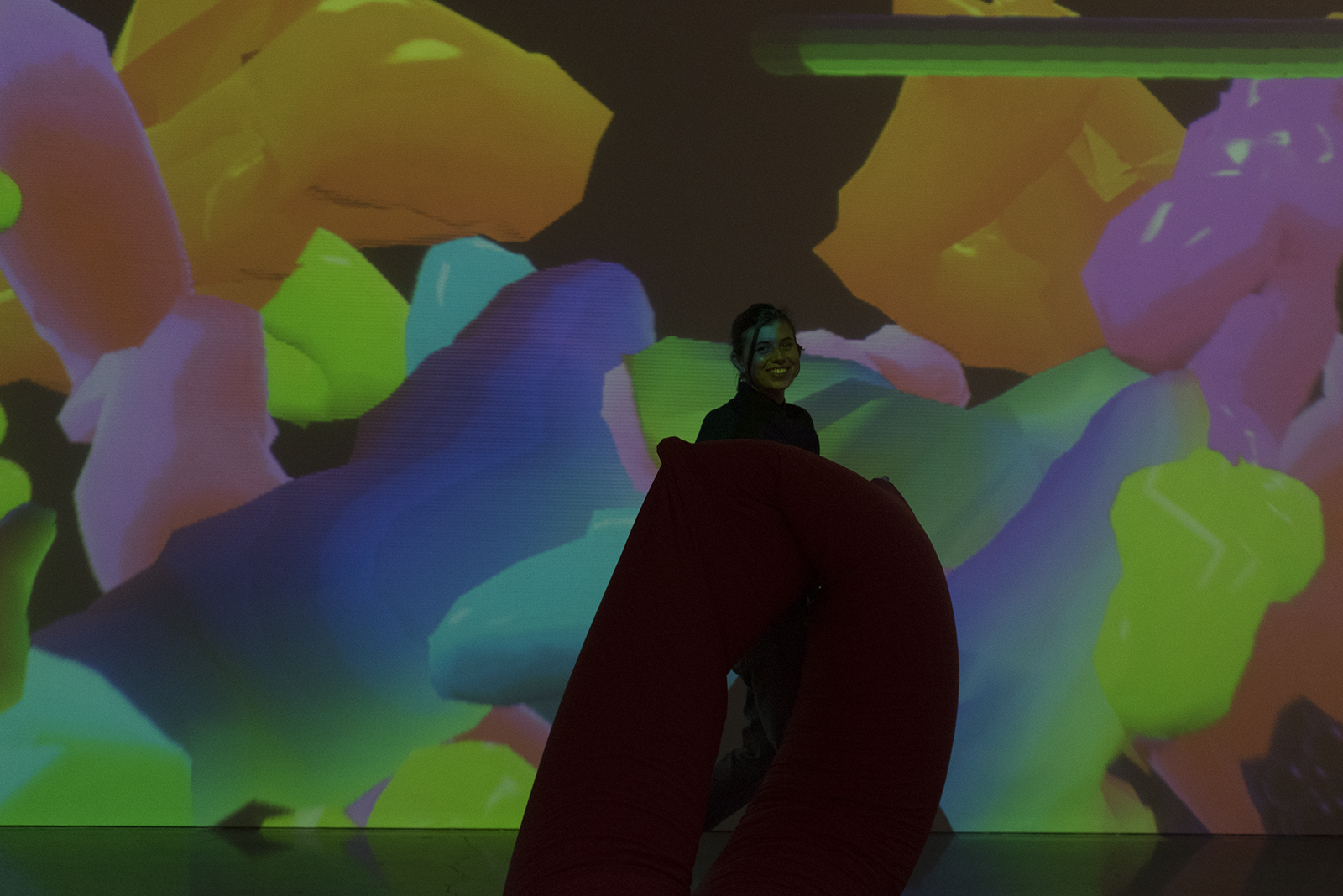‘Rare Meme’ exhibition explores Internet culture experience

Second-year Design | Media Arts student Isabella Kefgen walked through the “Rare Meme” exhibition carrying a large red noodle-shaped pillow. Theo Triantafyllidis, a Design | Media Arts graduate student, created the piece to represent an overload of information in social media. (Conor Cusack/Daily Bruin)
By Shreya Aiyar
Oct. 16, 2015 10:29 a.m.
In the UCLA New Wight Gallery, a spectator picks up one end of a 40-foot-long red, noodle-shaped pillow.
As she moves the noodle, sensors embedded in the fabric pick up twitches and vibrations. A computer integrates the motions to create digital projections of pink, yellow, green and gray amorphous blobs that color the walls of the enclosed space.
The digital, motion-sensitive work is part of an art collection displayed by the six second-year Design | Media Arts master of fine arts candidates in their fall exhibition, “Rare Meme,” which opened Thursday in Broad Art Center. The exhibition explores the students’ interpretations of Internet culture, ranging from facial recognition algorithms in Facebook to the piece involving the noodle, which represents an overload of information in social media.
To Theo Triantafyllidis, a Design | Media Arts graduate student and artist of the show, a meme is an image copied and mutated continuously by users, usually through the Internet.
Because their original pieces are influenced by Internet culture, Triantafyllidis said the artists decided to call the show “Rare Meme.”
The artists converted common Internet activities, such as tagging a photo, to modern art. Design | Media Arts graduate student and artist Adam Ferriss digitally rendered wall prints of faces contoured by Facebook facial recognition algorithms.
“Our work has ideas that could be shared and mutated and spread around, possibly through the Internet,” Triantafyllidis said. “At the same time, we know that our objects are unique in their nature, (resulting in) an interesting contradiction.”
Triantafyllidis said his piece involving the noodle is more influenced than defined by his interpretation of a meme – he used the concept of video games combined with the chaotic feeds of social media.
The lack of order in social media posts, Triantafyllidis said, made him think about how to translate the mashup of social media information into art.
On a Facebook feed, Triantafyllidis said users consume information like pictures of food and videos of recipes alongside stories and images of pain and suffering.
He said he smashes digital-colored shapes together in a way similar to how joyous and sad posts are put together on Facebook.
The projections are then partially controlled by the red noodle, representing the user who has only a little power to moderate the content of his or her newsfeed.
“(Information on social media) becomes this clump of events that reduce their impact,” Triantafyllidis said. “It all becomes this meaningless mass.”
Each artist has a slightly different idea of what a meme is, said Jesse R. Fleming, a Design | Media Arts graduate student and an artist in the show. To Fleming, a meme represents a mimicry of an idea that rapidly spreads from person to person, resulting in crowds drawing their focuses internally to the idea.
Fleming said his pieces aim to examine the effect of photos of crowds on the gallery audience. His laser-printed artwork combines black-and-white scenes of crowds in public spaces but removes the center of focus – the stage, the playing field – from the image.
The outcome, Fleming said, is a composite image of crowds focused on an invisible stage or playing field, which can elicit visceral, agoraphobic reactions in gallery audiences.
“The thing that became interesting was once I removed the center of the spectacle, there’s nothing to ground (the experience),” Fleming said. “I feel (those images) in my stomach. The terror is in my gut. And then the mind reacts.”
Fleming said the pieces created by the six graduate students are connected by the concept of unification.
A classmate from South Korea, who left the masters of fine arts program due to illness, taught Fleming the Korean word “jeong,” which he said represents unconscious unification between people, objects, conversations and states of being in moments of agreement or similar feeling.
Learning about jeong helped Fleming understand connectedness not only among people, but also among seemingly unrelated prints in a gallery space.
Jeong, Fleming said, was a thread that tied the artwork together, turning the gallery into a laboratory studying the human condition and reactivity to stimuli.
To Neil Mendoza, a Design | Media Arts graduate student and an artist in the show, the concept of eliciting strong reactions is the ultimate theme behind the exhibition.
Mendoza said the concept of reactivity to Internet culture drives the art forward.
“We all have very different work, but hopefully audiences feel something,” Mendoza said. “All artwork is trying to get the audience to feel something.”


